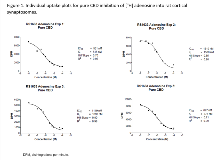The Proposed Multimodal Mechanism of Action of Cannabidiol in Epilepsy: Modulation of Intracellular Calcium and Adenosine-Mediated Signaling
Abstract number :
2.462
Submission category :
1. Basic Mechanisms / 1D. Mechanisms of Therapeutic Interventions
Year :
2018
Submission ID :
554059
Source :
www.aesnet.org
Presentation date :
12/2/2018 4:04:48 PM
Published date :
Nov 5, 2018, 18:00 PM
Authors :
Kathryn Nichol, Greenwich Biosciences, Inc.; Colin Stott, GW Research Ltd; Nicholas Jones, GW Research Ltd; Royston Gray, GW Research Ltd; Michael Bazelot, GW Research Ltd; and Benjamin J. Whalley, GW Research Ltd
Rationale: Cannabidiol (CBD) has shown anticonvulsant properties in preclinical studies and antiseizure effects in clinical trials of certain childhood-onset intractable epilepsies (Dravet and Lennox-Gastaut syndromes) with a unique molecular target profile. Although commonly misrepresented, CBD does not act through cannabinoid receptors at physiologically achievable concentrations. Here we present summary data highlighting CBD’s leading mechanisms of action in epilepsy. Methods: Preclinical evidence suggests CBD reduces neuronal hyperexcitability through multiple mechanisms, including modulation of intracellular calcium via G protein-coupled receptor 55 (GPR55) and extracellular calcium influx through transient receptor potential vanilloid type 1 (TRPV1) channels, in addition to modulation of adenosine transport. This preclinical evidence has been summarized to describe what is currently known about CBD’s multimodal mechanism of action in epilepsy. Results: CBD is a GPR55 antagonist. By the inhibition of intracellular calcium release, excitatory currents and seizure activity are decreased, Table 1.GPR55-mediated modulation of neurotransmission was potentiated in excitatory neurons and reduced in inhibitory neurons in a model of chronic epilepsy.CBD potently blocked GPR55-mediated increase of miniature excitatory postsynaptic current frequency in pyramidal neurons in both healthy and epileptic tissue.CBD did not affect GPR55-mediated increase of excitatory neurotransmission in inhibitory neurons in healthy tissue.CBD’s anticonvulsant properties were attenuated in GPR55 knockout (KO) animals.CBD is a TRPV1 agonist that rapidly desensitizes the function of the TRPV1 channel. The resultant decrease in extracellular calcium influx decreases neurotransmission, Table 1. TRPV1 channels are overexpressed in models of temporal lobe epilepsy and patients with epilepsy.The dose-dependent, CBD-mediated increase in seizure threshold seen in wildtype (WT) mice was significantly attenuated in TRPV1 KO mice.Brain CBD concentrations were consistent with those required for TRPV1 activation and desensitization irrespective of genotype.CBD inhibits the equilibrative nucleoside transporter (ENT1), reducing adenosine reuptake. Extracellular adenosine is thereby increased, reducing hyperexcitability and neurotransmission, Figure 1.CBD inhibited [3H] adenosine uptake into rat cortical synaptosomes at low micromolar concentrations. Conclusions: While the precise mechanisms by which CBD exerts its anticonvulsant properties in humans remain unknown, growing preclinical evidence suggests that CBD reduces neuronal hyperexcitability through a unique multimodal mechanism of action, distinct from other antiepileptic drugs. CBD antagonizes GPR55 at excitatory synapses, desensitizes TRPV1 channels, and inhibits adenosine reuptake. Further exploration of these and other potential targets will have important implications for patients with intractable epilepsy and related conditions. Funding: GW Research Ltd, Cambridge, UK

.tmb-.png?Culture=en&sfvrsn=115e18f5_0)